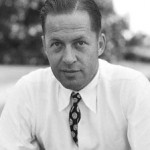 THE R&A’s OFFICIAL OPEN CHAMPIONSHIP MAGAZINE
THE R&A’s OFFICIAL OPEN CHAMPIONSHIP MAGAZINE
When Bobby Jones stepped onto the first tee of the Old Course for his opening drive of the 1927 Open, his place in the pantheon of St Andrews greats was far from assured. His first visit to the hallowed links six years earlier had ended in public ignominy.
As a raw 19-year-old, he first came to Great Britain in 1921 as part of a team of American amateurs competing against their British counterparts in a match that would, the following year, become known as the Walker Cup. The young Jones had something of a reputation, with ‘the face of an angel and the temper of a timber wolf’, as one commentator put it.
Despite publicly stating his dislike for the course, after 36 holes of that year’s Open, Jones was the leading amateur. But the opening nine of his third round took a miserable 46 shots. He then racked up a double bogey six at the par four 10th. On the short 11th, he hit his ball straight into Hill Bunker, which still guards the green today, and after four attempts, he eventually picked up without completing the hole.
Disqualified from the tournament, it was, by his own admission, his ‘most inglorious failure’ in golf. The locals weren’t impressed either. ‘Master Bobby is just a boy, and an ordinary boy at that,’ was the opinion expressed in the press.
Six years on, it was all change. Jones returned to a still-skeptical St Andrews as the all-conquering hero. The previous year, he had been fêted with a New York ticker-tape parade after completing the double of US and British Open victories, the only amateur golfer to achieve the feat.
There is some debate today about whether Jack Nicklaus or Tiger Woods is the greatest-ever golfer, but there can surely be no question that Bobby Jones was the best part-time player of all time. Despite spending more time studying law than playing golf, he was never beaten by either of his two professional rivals, Walter Hagen and Gene Sarazen, in a US or British Open.
By 1927, Jones had also quieted his demons and acquired an enviable reputation for fair play. He was particularly lauded after calling a penalty on himself when, in the 1925 US Open, his ball moved a fraction in the rough after he had addressed it. As no one else had seen the incident, officials left it to Jones. He called a two-shot penalty on himself, and lost the tournament by a single stroke. Dismissing praise for the gesture, he said: ‘You may as well praise a man for not robbing a bank.’
The 1927 Championship had a notable field with the young Henry Cotton playing his first Open, the five-time winner, 56-year-old J.H.Taylor, playing his last, and the legendary six-time champion, 57-year-old Harry Vardon playing his 28th.
Wearing baggy plus fours, cloth cap and tie, Jones played a brilliant first 18 holes. In the words of The Times’s golf writer, Bernard Darwin, his swing possessed ‘a drowsy beauty’. A series of long putts, including a monster at the 5th, resulted in a stunning 68, the round of the tournament.
Twenty-year-old Henry Cotton was five shots back on 73, with Joe Kirkwood, Jones’s American rival, closest to him on 72. After the second round, the lead was down to two shots, with Welshman Bert Hodson on 142 to Jones’s 140. But, by now, the defending champion had the measure of the Old Course, and a third round 73 followed by final 72 saw him safely home by six strokes, with a record aggregate of 285.
It was a hugely popular win. After his tap-in on the 72nd hole, Jones was engulfed by a huge, cheering gallery. Channel Islander Aubrey Boomer tied for second place with Fred Robson, who had raced through the field with a third-round 69. Cotton, who would go on to win three Opens, was ninth, 13 strokes behind the winner.
It was Jones’s sixth Major victory – in those days, the four Majors were the US and British Amateur and Open tournaments. He would go on to win 13, including the Grand Slam of all four titles in 1930.
But whatever the achievements to come, his Open triumph at St Andrews created a deep bond of friendship and respect between Robert Tyre Jones and the ‘home of golf’. Wearing a tweed three-piece suit to accept the Claret Jug, he endeared himself to all by declaring that the trophy should henceforward remain in the safekeeping of the R&A rather than return with him to Georgia.
Receiving the Freedom of the City in 1958, he said: ‘I could take out of my life everything except my experiences at St Andrews and I would still have a rich, full life.’
